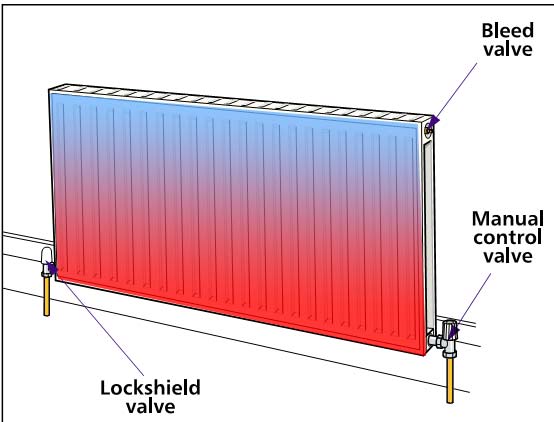Bleeding (venting) a Radiator
What is bleeding a radiator?
At some point we have all heard the term 'bleeding' the radiators. It's not just some dark art that only the men of the house knew how to do. Exactly what is it, and when do we do it?
Your gas boiler heats up water flowing around it, and in turn distributes it around the radiators. However, every now and again, you can get a pocket of air at the top of radiators, and this air just sits there, not passing through the boiler, so not warming up. How the air gets there we discuss in later articles.
Radiatior needs bleeding when cold at top and warm at bottom |
|---|
When to bleed (vent)?
Turn your heating on to warm the system up, and check for cold spots. We only bleed when the top of the radiator is cold, and the bottom is noticably warmer. Please note, that we do not need to bleed every single radiator unless they are cold at the top. Please check them first by feeling for cold spots at the very top. I have heard stories of people with jugs and bowls, drawing out gallons of water from radiators unnecessarily. I can think of many better things to be doing! Do you turn the boiler and heating off when doing it? Sometimes they will bleed (vent) quicker when the heatings on as the pump aids the air in being forced out. However some can be damaged by the drop in pressure in the system when you bleed the air out. So it's best to turn off the heating and boiler just to be sure.
How to bleed (vent)?
Locate the air bleed on your radiator. This can be on the side, at the back (sometimes with a plastic dome cap on which you need to remove first) or on the top (such as on a towel warmer). It is a small square nib. Now place the Radiator Bleed Key onto this nib with one hand, and turn gently anti clockwise. This is letting the air out, and we need to shut off as soon as water comes out of the radiator, by turning clokwise. Do not overtighten! Remember to have an old rag or cloth handy for any spills of water.
Finally, if you have a combi or sealed system, you will need to top up the pressure, as bleeding the radiators will mean the pressure drops.
A word of caution
You only need to open the bleed screw by turning the bleed key until you can here air coming out. This is normally half a turn anti-clockwise at the most. If you open it too far, the bleed screw will come out, and you may get wet! If nothing comes out it's either; blocked, or there's no water in the system, so you may need a plumber to take a look.
There are several bleed keys available, some are really small. The reason they are small is so you cannot overtighten the bleed screw and snap it off! Please be careful not to overtighten bleed screws, ultimately they are just a fine brass nib to stop the water coming out of the radiator!
Some types available are;
|
Small bleed key
|
|---|
|
Large Bleed Key
|
|---|
|
Cast Bleed Key |
|---|
The brass keys tend to be a bit more robust than the cast keys, however, they are not as tight a fit on the bleed screw than the cast keys, due to the way they are manufactured (Drilled first and then squared off) The downside of the cast keys however is they are very weak compared to the brass keys.




